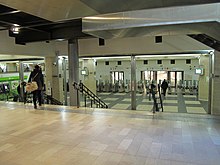Gare de l'Est (Paris Metro)
|
Verdun |
|
|---|---|

|
|
| Tariff zone | 1 |
| Line (s) |
|
| place | 10th arrondissement |
| opening | November 15, 1907 |
Gare de l'Est is an underground transfer station of the Paris Métro . It is served by lines 4 , 5 and 7 and bears the name “Verdun”.
location
The subway station is located roughly in the middle of the 10th arrondissement of Paris . Its stations are located immediately south of the Gare de l'Est long-distance train station under the forecourt, which is called Place du 11 Novembre 1918.
Surname
The name is given by the long-distance train station above, which was given its current name in 1854. In the Franco-Prussian War (1870/71) as well as in the First World War (1914–1918), soldiers were promoted eastwards to the front. The nickname "Verdun" is a reminder of this: in 1916, more than 600,000 soldiers lost their lives in the Battle of Verdun .
history
The first station went into operation on November 15, 1907 with the opening of the northern extension of line 5 from Lancry station (since 1946: Jacques Bonsergent ) to what was then the terminus Gare du Nord . It was laid out in the western part for four tracks on three platforms so that line 7 could also be added three years later.
On April 21, 1908, the station of line 4 was opened, which initially led from Porte de Clignancourt only to Châtelet . The last extension followed on November 5, 1910, the opening of the station of line 7. The first section connected the subway stations Porte de la Villette and Opéra .
description
The stations of lines 5 and 7 have the original Parisian standard length of 75 m, that of line 4 was extended to 90 m in the mid-1960s. The tracks of lines 5 and 7 are on the same level, with those of line 5 following a curve. Their side platforms in the north direction unite about half their length to form a common central platform, in the eastern area there are level crossings. For the journey south, line 7 has a separate side platform on the north side of the facility, line 5 on its south side.
While the eastern sections of both stations have elliptical cross-sections, the cross-section is rectangular after their union. There the ceiling consists of iron transverse and longitudinal girders, on which small, brick-built vaults rest. To the west of the common station is a simple track change between the tracks leading to the north, then the tracks of line 7 pass under that of line 5. Before that, the station of line 4 is crossed at the western end of the station.
The cross-section of the lower station on line 4 is elliptical throughout. However, the curvature of the ceiling is interrupted at the point where the tracks of the other two lines cross the station.
Of the total of eight exits, one leads directly into the counter hall of the long-distance train station.
vehicles
Line 4 is one of the lines whose vehicles run on gas-filled rubber tires. Trains from the MP 89 CC series are on the move there. On lines 5 and 7, the trains run on conventional rails. Line 5 is used by MF 01 trains, line 7 with trains from the MF 77 series .
traffic
The subway station is an important transfer hub in the center of the city. With around 43,000 passengers a day, in 2004 it was the fifth busiest station on the metro. You can change to the RER E at the Magenta tunnel station , which is east of the Gare du Nord . The Gare de l'Est is the main station for long-distance and high-speed trains in the direction of Strasbourg , Metz and southern Germany.
literature
- Gérard Roland: Stations de métro. D'Abbesses à Wagram . 2003, ISBN 2-86253-307-6 .
Web links
Individual evidence
- ^ Jean Tricoire: Un siècle de métro en 14 lignes. De Bienvenüe à Météor . 2nd Edition. La Vie du Rail, Paris 2000, ISBN 2-902808-87-9 , p. 197 .
- ^ Gérard Roland: Stations de métro d'Abbesses à Wagram . Christine Bonneton, Clermont-Ferrand 2011, ISBN 978-2-86253-382-7 , pp. 109 .
- ↑ Jean Tricoire: op. Cit. P. 197.
- ↑ Jean Tricoire: op. Cit. P. 183.
- ↑ Jean Tricoire: op. Cit. P. 222.
- ^ Brian Hardy: Paris Metro Handbook . 3. Edition. Capital Transport Publishing, Harrow Weald 1999, ISBN 1-85414-212-7 , pp. 36 .
- ↑ Sommaire. (PDF; 1.1 MB) (No longer available online.) P. 16 , archived from the original on June 17, 2012 ; Retrieved July 16, 2010 (French). Info: The archive link was inserted automatically and has not yet been checked. Please check the original and archive link according to the instructions and then remove this notice.
| Previous station | Paris metro | Next station |
|---|---|---|
|
Gare du Nord ← Porte de Clignancourt |
|
Château d'Eau Mairie de Montrouge → |
|
Gare du Nord ← Bobigny - Pablo Picasso |
|
Jacques Bonsergent Place d'Italie → |
|
Château Landon ← La Courneuve - May 8, 1945 |
|
Poissonnière Mairie d'Ivry or Villejuif - Louis Aragon → |
Coordinates: 48 ° 52 ′ 34 " N , 2 ° 21 ′ 30" E




